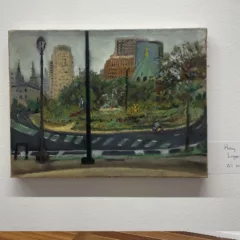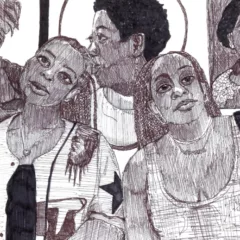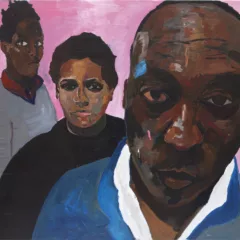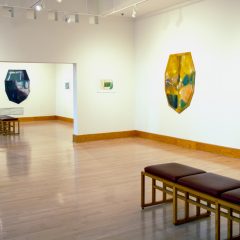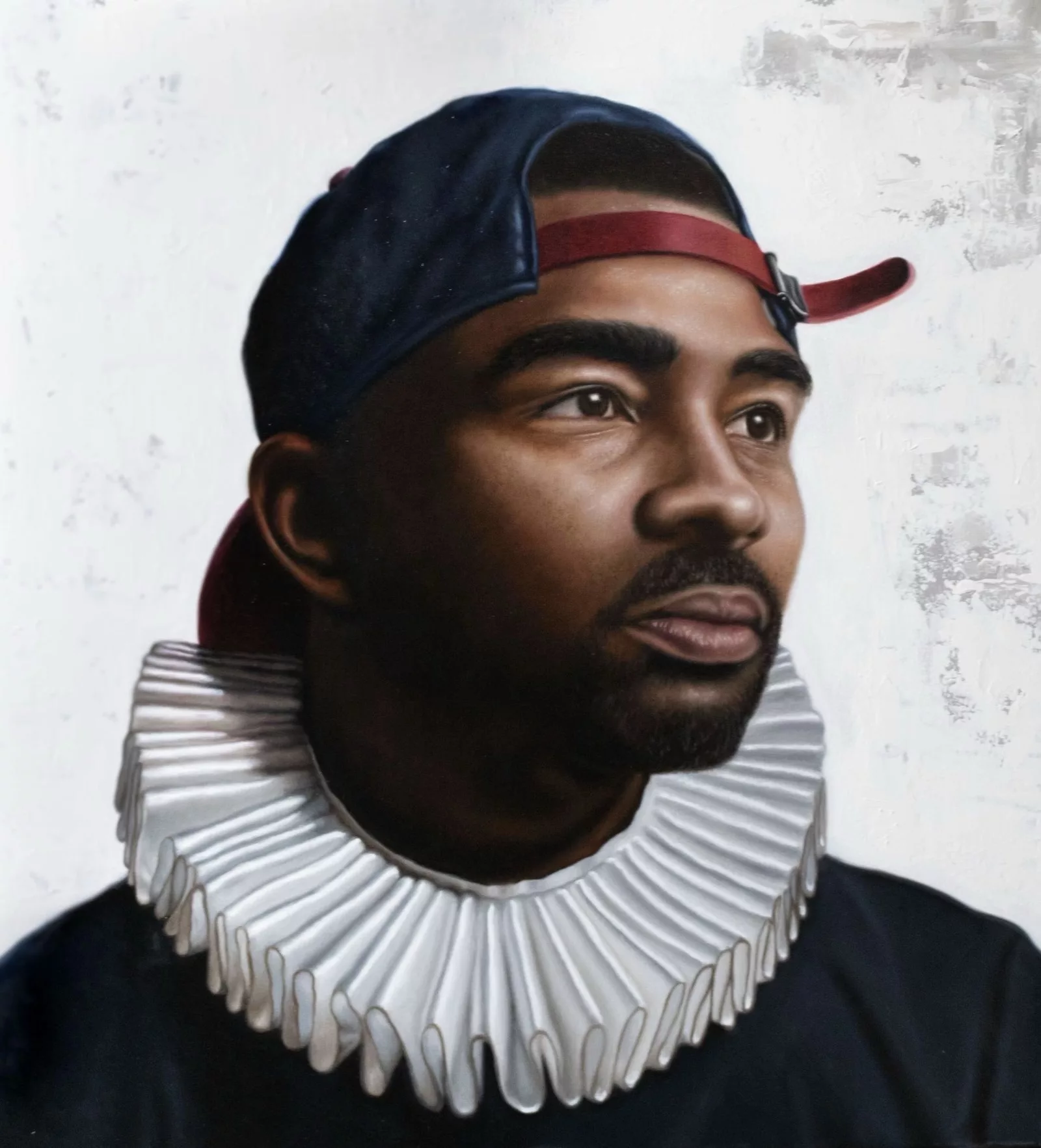
I first saw a painting by O’Neil Scott at Arch Enemy Arts in Old City. Titled ‘Bridge the Gap”, the work was a square self portrait; an exquisitely rendered three-quarters head against an expressionistic white background. Next, I saw his one-man show at Corridor Contemporary during June of 2023. His vocabulary fused hyperrealistic old-masterly painterliness with symbols and color fields. The work made quite an impression. I was fascinated by this Philadelphian who was turning out world-class work. In August of 2024 I had an opportunity to travel out to West Chester, PA, to his studio and newly acquired home for a leisurely discussion about his life and art. The house was set in this intensely green verdant glen. It had been raining that day which made everything more lush. There was a pile of construction debris outside. O’Neil had set up his studio in the garage, which was immaculate.
We started off the discussion talking about the house. A summary and synthesis of that discussion follows.
Pete Sparber: Did you know what you were getting into before you closed on the property?
O’Neil Scott: Not at all. The housing market is crazy right now. We knew we wanted an older house. We love that aesthetic and the character you get with an older home. It’s one of those things where you take on a project but you don’t know everything about it. And we had to move quickly because every house we looked at went so fast. My daughter loved it, my partner loved it and I loved it. At this point we’ve moved in, but we’ve been without a kitchen for over a month so it’s kind of hard. But we’re making it work, slowly but surely. (Note: two guys showed up at the close of the interview to install a kitchen counter!).
That led into a discussion about how the environment can affect the choices you make in painting.
O’Neil: I was in New York on Wednesday meeting with galleries. We’re working on a two-man show for next year with Tim Okamura. I don’t know if you know Tim. He’s an incredible portrait painter. We were talking through the logistics of the show and I was telling him I had just moved. We had lived on a busy street…people everywhere. But then you move into something like this and it’s a lot more secluded. It automatically changes the way you want to paint and your perspective. I already feel the need to put more nature into the work. In the morning you’ll see a deer right out front. There’s a farm down the road with horses. You start noticing these different (aspects of nature) and you feel the need to put them into the work.
Pete: I mean, you’re immersed in your environment. The color and the texture and the sense of space all change, right?
O’Neil: Yes. Your sense of color changes. I think the colors (in the work) are becoming more muted, more like earth tones. More of the colors that you see in nature. I love them. I think it also lends to a more sophisticated palette. It is interesting how all that seeps in.
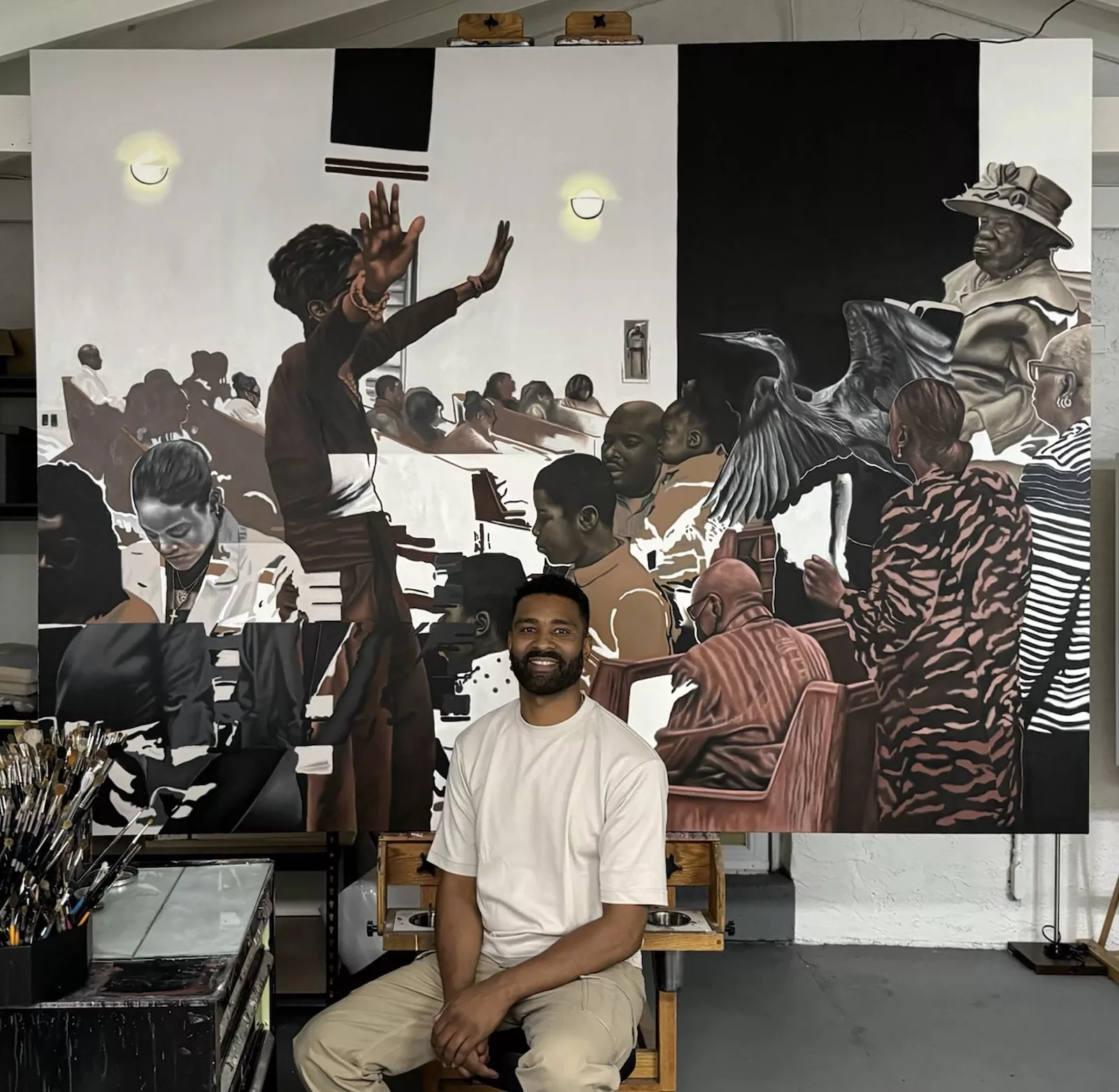
The Studio was dominated by a very large, very dramatic painting of a church interior (titled “In Case of Emergency”). I could see that this was going to be a spectacular painting and I hadn’t seen anything on this scale from O’Neil before. I wanted to know about this painting and understand his current interests and focus.
O’Neil: This (referring to the oversized canvas) is for a show at the Zillman Museum of Art, which is associated with the University of Maine. The show will be up from mid-May through the beginning of September (2025). I also just received a big commission from Vanguard (the financial services firm). They’re making an effort to engage their minority clients and give them a better understanding of investing. I’m going to paint some of their minority financial advisors. The work will be housed at the Vanguard campus, but then they’ll also move the work around. It’ll be portraiture, but they want me to stay consistent with my style. They’re giving me free reign.
(Coming back to the large canvas) I’m thinking about (how in some paintings) many things are happening. There’s a lot of Renaissance work where they compile images and you’re able to sit with the work a lot longer and find nuances over time. That’s what I’m hoping for. There’s an overall idea and focus, but within each work there are layers you can peel back and find different meanings within those layers.
Pete: I can see that it’s going to be fantastic. Have you done something like this before?
O’Neil: No, this is probably the largest piece. You know what’s weird? Even though you get an idea and a sense of where you want to go with the piece, along the way you’re making changes and you’re editing. So even though we see it right now, every day I come in and think ‘I should change this part, or I should add to this’. Then it turns out to be wildly different. But yes, I like that piece and this is probably how I want to paint. But depending on where you’re showing not every place lends itself to this scale.
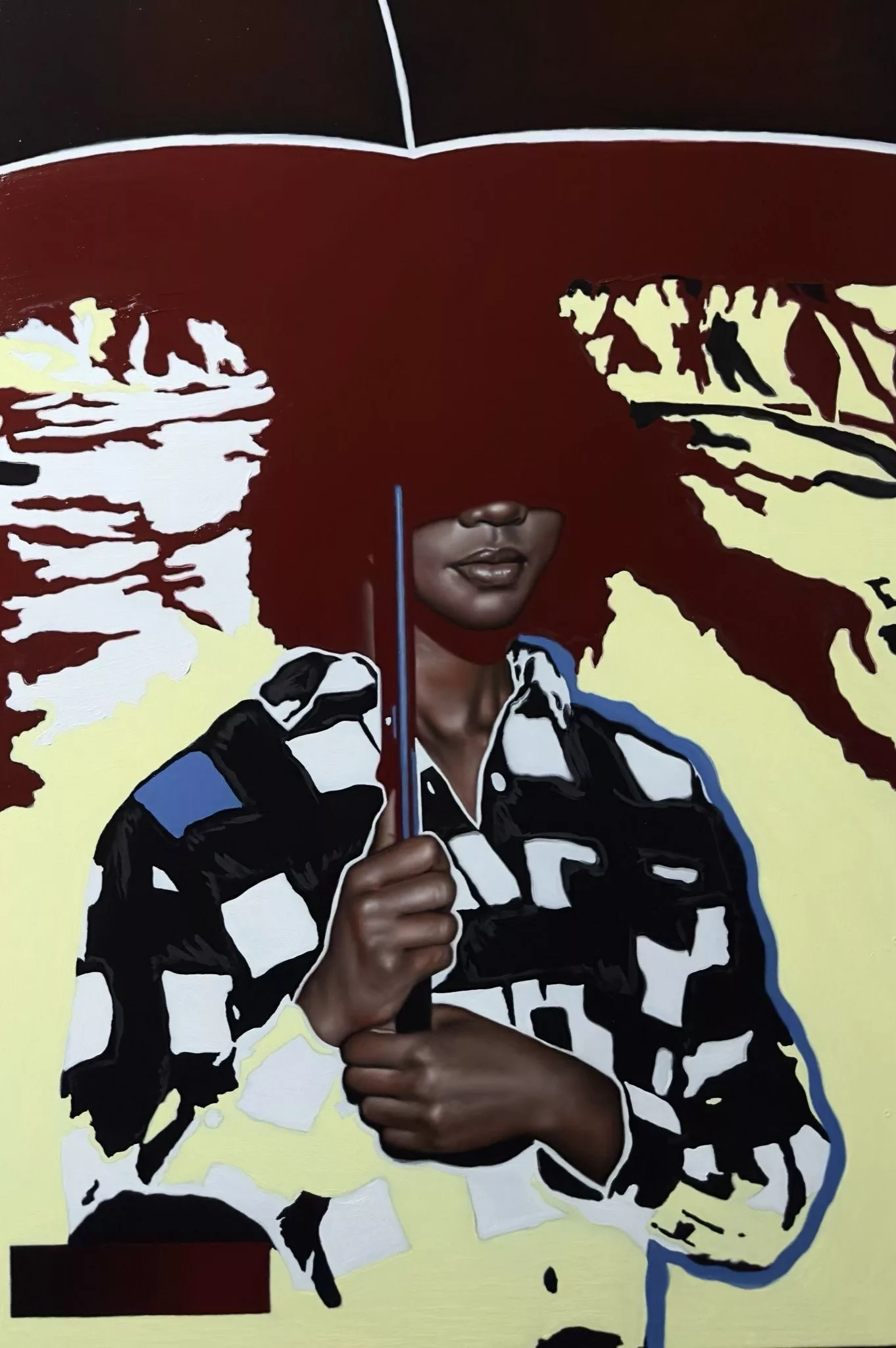
Pete: This is like cinema. It’s a theatrical experience. You’ll see those shows where there’s a focus on a few large canvases, but many smaller canvases.
O’Neil: You hit it right on the head. That’s exactly where it’s going. There are going to be some of those more focused, more intimate pieces, and then there are going to be some where you’re immersed, and it’s telling a story.
The museum show is really centered around my life and my experiences growing up, the areas that affected and molded me. It’s like self-meditation and self growth. (Gesturing to the painting) this is my mom’s church, but it’s reflective of me, of when I was growing up. I went to an afterschool program at the Salvation Army right across the street from my house. They taught the Bible and we had recreational time with the other kids. But the main part was centered around the church. This is a snippet of that, going to that church and having that affect my life in a certain way…being able to understand that side of religion in depth.
Pete: You were saying it’s kind of meditation or self-discovery. I can’t imagine working on a painting like this…it must be a pretty rich adventure. Can you talk a little bit about that?
O’Neil: Just to give you a quick example, as I was painting I was thinking about photos my mom took when she was at the church. (Pointing at a pensive figure in the painting) like with this guy. He’s reflecting on something. He may be in prayer. And even though we’re in communion, he’s wearing the covid mask. There are so many things that affected his life and are affecting our world in general, and still affecting it. It’s something that’s part of everyday life and has become the norm. (Pointing to another figure) this dad with his three kids reminds me of me, my brother and my sister. The father is being very protective. There are so many little nuances. I tried to make them representative of who they are, but then also it can be anyone…someone that we’ve seen on the street. And I think most of the figures in here are like that except for her (referring to an elderly woman). She’s an older lady and the shadows become important because of her hat covering (a portion of her face). I wanted her to be really representative of who she is because I knew her for a very long time. I wanted her to be that quintessential representation of the Black church. Folks call her mother. She’s probably the oldest person at the church.
The large painting then served as a jumping off point for discussing O’Neil’s history…his formative influences and the events that launched his career as a painter.
O’Neil: The working title for the show is ‘A Tale of Two Worlds’ or ‘A Journey to Distant Memories’. It’s growing up in a low income household and going through what I’ve gone through in my life. Starting in Jamaica and the transition (to the US), my childhood and then all the way up to where we are now. To me that feels like two different worlds. It’s also a reference on the technical level…the way I’m painting hyper realistically, or however you want to label it, and then pulling in abstract elements and flatness.
Pete: So, let me try to get a little bit of the narrative. You were born in Jamaica?
O’Neil: My mom, like many immigrants (felt) ‘I’m going to go to America and make a better life’. So she left, and until I was about five I was raised by my grandparents and my uncles. Then she came back, got me, and brought me to the US. We lived in New York for a bit then we moved to Philadelphia, and then to Camden until I graduated high school. My father passed away when I was 11.
When I was in Jamaica my grandfather was the architect of the neighborhood. We were in Spanish town, which is the ‘country’ part of Jamaica. He would draw up the plans and build all the houses. And my uncle was an incredible artist. He could draw anyone at any time, and I think that drew me in. Then when I was in Camden I found a group of kids that always drew. I found out that when I drew in class I would remember and recall everything, so I actually got really good grades. We would draw comic books…just make them up. There were these two older kids who were incredible. They drew off the top of their heads and we started mimicking them.. so we started remembering how characters looked and everything they wore. My art teachers (advised me) to enter competitions, and in middle school and high school I was winning competitions. I wound up getting two scholarships. One for the University of Arts. They (my art teachers) were putting my stuff out there. They really believed in me.
Pete: So where did you end up going?
O’Neil: I ended up going to Syracuse University because I was an athlete in high school. I started playing football when I was in the 10th grade. In the summer of the 11th grade I went to a skill camp at Rutgers. They offered me a full scholarship on the spot. I was like, ‘Whoa,’, you know at the time I didn’t even think about going to college because we didn’t have the money and I didn’t want to put that burden on my family. After Rutgers offered me a scholarship, it just spiraled, and by the beginning of 12th grade I probably had 30 scholarships. I even had an offer from Princeton…it was insane. Looking back on it, I probably should have taken the Princeton (scholarship) but I wanted to play big time college football. At the time Syracuse was incredible.
It was interesting…on their recruiting visit they come to your house and your parents are there. They came to my house, and we sat down, and we looked at sketches and we looked at my portfolio, and we looked at paintings. These are football coaches and I’m sure they didn’t think we’re gonna be sitting here looking at paintings. But they seemed like they were genuinely interested in me pursuing art and I think that was one of the biggest sales (points) for Syracuse. Then on my visit to the school I was separated from the recruiting class and they took me directly to the VPA (visual and performing arts) building. I sat down with some of the life drawing professors and they walked me through their setup and the classes.
Pete: They clearly wanted you and maybe this is giving them too much credit, but they would realize your understanding of pattern recognition and the way things move would be part of your talent in the game.
O’Neil: I do think so. I believe some of the smartest people in history were talented artists. Just great thinkers and the way they put things together. And you’re right, the pattern recognition, drawing from that and being a lot more observant.
Pete: So, you’re at Syracuse playing football…
O’Neil: So we’re in Syracuse. During my first year I did all my foundation classes; life drawing, 3D, 2D, painting with acrylics and I wasn’t playing much. I redshirted my freshman year. While the team was traveling I was focused on my studies. Then sophomore year came and I began to play, and that’s when you had to declare your major. I decided to do ad design. I figured it was something that would make money and I would still be able to use my creativity.
When I went to set my schedule for the year I realized the studio classes were towards the end of the day, cutting directly into practice. Being a kid I really wanted to play football. I sat down with the coaches and talked about it. So, I’m here on a football scholarship. I’m always gonna draw. Maybe I could do something else and eventually come back to art. I ended up changing my major, playing football the whole time and graduating with a totally different degree (than art).
Sometimes you never know the winding path. There are so many different ways, no one has the same path. How do you get here? How do you get into galleries? Some people are plucked right out of school. But some folks have to find a different way.
I got an IT job and went to the University of Delaware to get my MBA. All this time I was still drawing. I never touched oil paint. It was just like one of those things where a button got pressed. I felt like something was missing. I was looking at a lot of art and I started following artists, like Bo Bartlett, Vincent Desiderio…these figurative realists that were working out of Philadelphia. (I asked myself) why not just create a body of work? It may not go anywhere, but let’s just see what happens.
Pete: How old are you at that point?
O’Neil: Late twenties. I started painting. I never touched oil paints before. I did a lot of research. I took a workshop in Philadelphia with Kerry Dunn. You know Nelson Shanks, a really huge portrait painter? He founded a school in South Philly, Studio Incamminati, at the Bok building. At first I painted a lot of family members. I thought they (the paintings) were great, but they weren’t really that great. But I did one very big self portrait and posted it on Instagram. A gallery in Provincetown reached out to me. (The gallerist, Carolyn Kramer) was like…’Oh my God…I really love that painting…I would love it in this group show. At the time I knew nothing about galleries. But once it was up the whole town was talking about it. She said that as soon as she opened the door the painting sold in two seconds. After that everything spiraled. The painting ended up on the cover of their local magazine, and she made a print so other folks could get it. She connected me to a bunch of people that helped me write bios and to other galleries and artists. After that there was no looking back.
Now I’ve become very selective. I get a lot of inquiries. I get a lot of galleries that want me to participate in stuff. Especially recently I’ve been focused on the museum show, so I’ve been pushing a lot of things back. But there are some galleries that I’ll still work with and try to get pieces to if I have time. I have three main art advisors. They have such a huge client list and continue to develop new clients and do different things…maybe they’ll do an art fair or a curator show. Even the piece that went to Villanova was created for the museum show, but it was already sold by one of the advisors. So that’s the nice part about it. I haven’t been out there seeking clients or even galleries.
Pete: So the demand has exceeded supply.
O’Neil: Yeah. It’s been good because they are able to move work so I don’t really have to worry. This year I’m hoping to do Art on Paper, a solo show in New York; a two man show with a working title of ‘Color Theory’, and then we have the museum show (at the Zillman Museum).
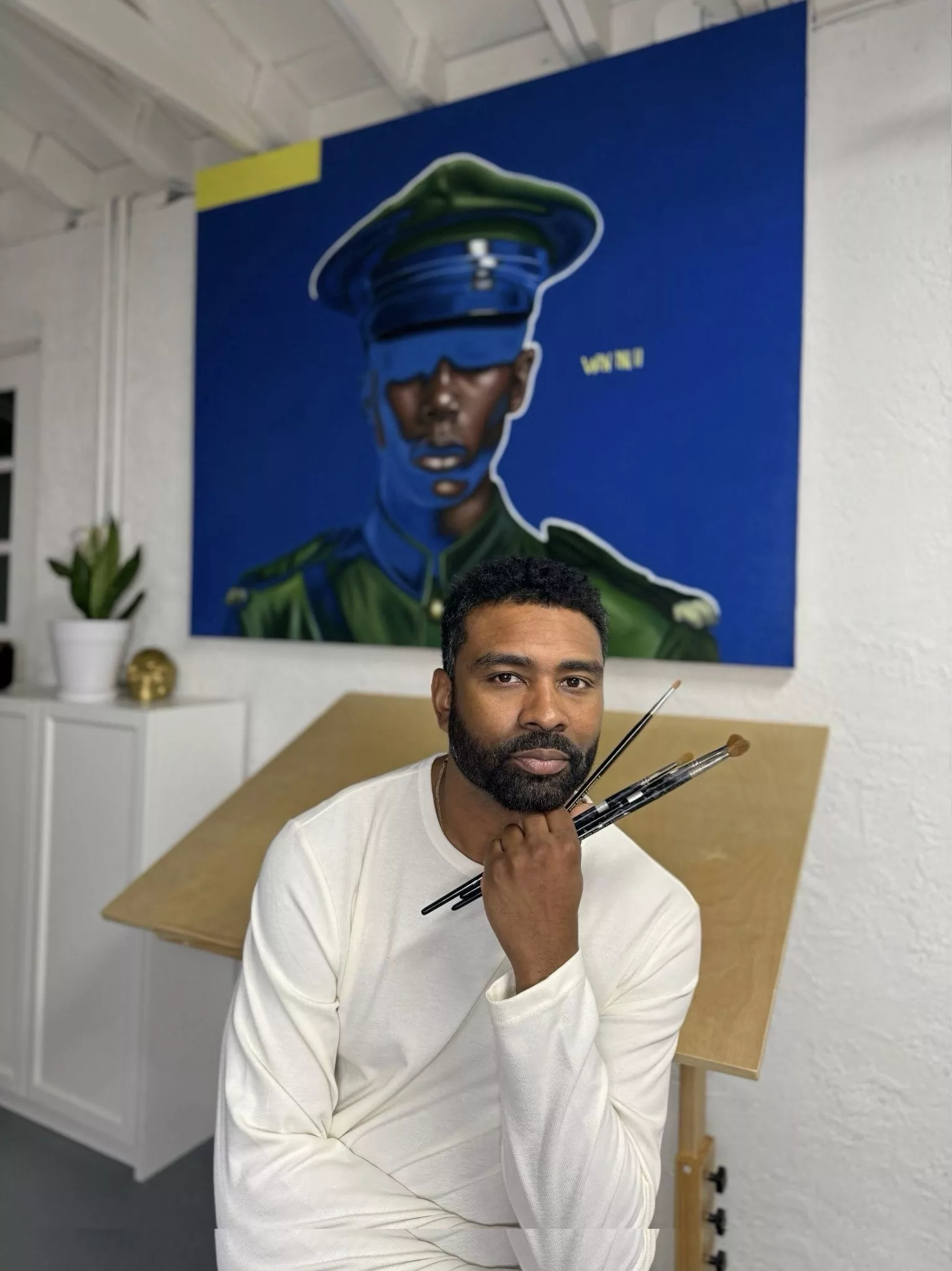
O’Neil’s work shows technical mastery with paint, layering, and use of color. I wanted to come back to some of the specific study he’s done to build that mastery.
O’Neil: I studied technique a lot. I’ve read a lot. I looked at a lot of art. It’s about training your eye. You just have to be obsessed with and fully immersed in the type of painting you like. Even if you have a specific talent, (for example) if you’re born with an understanding of proportion and specific taste for color, what colors go together, you have to train yourself to observe. For instance, to get a better understanding of how edges work and the change from hard edges to soft edges, how to make a figure turn in space. Being able to adjust the lighting, so you feel that sense of drama. It’s conscious…it’s not an accident. I love when you see the darkest dark and the lightest light, And how do I make sure that (the painting) encompasses the entire space? That’s what I try to put in each piece and bring forth… a lot more drama and emotion, especially with the shadows. I love things that are older but brought to the contemporary world. Even if you’re painting like the old masters, I love making those pieces feel like they were painted in the contemporary world…in the world that we live in now.
Over time you develop an artist’s hand, almost like their fingerprint. When you see work from artists, especially self-taught artists, their work is highly recognizable. You can pick them out of a lineup and spot them across the room. You see that with Barkley Hendricks, where It doesn’t matter what room you put him in and doesn’t matter what he paints. You’ll know it’s his. And I’m hoping my hand is strong enough and comes across that way.
There were three strategically placed paintings in the studio. We talked about the three and their significance.
O’Neil: “Free Thinker.” This was an older piece. I was working through my natural representational skill set. “Soul Her” …this is a newer piece. I like having this here. It reminds me of where I want to go with my work; to mesh together representation with abstract contemporary work and color theory. “Worlds Apart”…this piece is simpler…it’s a confidence builder. I look at this and I think I can paint anything, I can do anything. The words have significance…”Win VII,” let me make something amazing every day of the week…move beyond what I see in reality.
Pete: Where you do you see your work going from here?
O’Neil: There’s no roadmap. I just honestly want to have and show work that’s meaningful, and work that continues to evolve. I want to be able to look back 10 years from now (and see) growth. I want to continue having an uplifting message. I always lean towards progression, whether that’s for oneself, the viewer, or a broad audience where it can impact a lot more people.
As I left the studio I asked about a great big Ducati motorcycle next to the garage door.
O’Neil: This thing? Oh God. Yeah. I had a smaller one and my brother kept borrowing it. And I had it for such a long time I just said ‘I’m gonna get my own, and you can keep that one.” This was my Covid ride.
O’Neil assured me he always wears a helmet when he rides.
That’s good to know since this is one artist that needs to stay around, painting and creating. He’s developing a career and a body of work that reflects both the highest levels of craft and technique, but tells a very human, very uplifting story that will stand the test of time.
O’Neil Scott’s Upcoming shows
A Journey to Distant Memories, Zillman Museum of Art
Color Theory, New York City, location TBA
Read more articles by Pete Sparber on Artblog.


